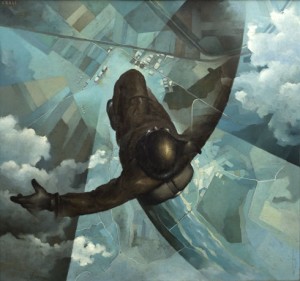NEW YORK, US – From February 21 through September 1, 2014, the Solomon R. Guggenheim Museum presents Italian Futurism, 1909–1944: Reconstructing the Universe, the first comprehensive overview in the United States of one of Europe’s most important 20th-century avant-garde movements.
Featuring over 360 works by more than 80 artists, architects, designers, photographers, and writers, this multidisciplinary exhibition examines the full historical breadth of Futurism, from its 1909 inception with the publication of Filippo Tommaso Marinetti’s first Futurist manifesto through its demise at the end of World War II.
The exhibition includes many rarely seen works, some of which have never traveled outside of Italy. It encompasses not only painting and sculpture, but also the advertising, architecture, ceramics, design, fashion, film, free-form poetry, photography, performance, publications, music, and theater of this dynamic and often contentious movement that championed modernity and insurgency.
The exhibition is organized by Vivien Greene, Senior Curator, 19th- and Early 20th-Century Art, Solomon R. Guggenheim Museum. An international advisory committee composed of eminent scholars from many disciplines provided expertise and guidance in the preparation of this thorough exploration of the Futurist movement, a major modernist expression that in many ways remains little known among American audiences.
This exhibition is made possible by Lavazza.
Support is provided in part by the National Endowment for the Arts and the David Berg Foundation, with additional funding from the Juliet Lea Hillman Simonds Foundation, The Robert Lehman Foundation, and the New York State Council on the Arts.
The Leadership Committee for Italian Futurism, 1909–1944: Reconstructing the Universe is also gratefully acknowledged for its generosity, including the Hansjörg Wyss Charitable Endowment; Stefano and Carole Acunto; Giancarla and Luciano Berti; Ginevra Caltagirone; Massimo and Sonia Cirulli Archive; Daniela Memmo d’Amelio; Achim Moeller, Moeller Fine Art; Pellegrini Legacy Trust; and Alberto and Gioietta Vitale.
This exhibition is supported by an indemnity from the Federal Council on the Arts and the Humanities.
About Futurism
Futurism was launched in 1909 against a background of growing economic and social upheaval. In Marinetti’s “The Founding and Manifesto of Futurism,” published in Le Figaro, he outlined the movement’s key aims, among them: to abolish the past, to champion modernization, and to extol aggression.
Although it began as a literary movement, Futurism soon embraced the visual arts as well as advertising, fashion, music and theater, and it spread throughout Italy and beyond. The Futurists rejected stasis and tradition and drew inspiration from the emerging industry, machinery, and speed of the modern metropolis.
The first generation of artists created works characterized by dynamic movement and fractured forms, aspiring to break with existing notions of space and time to place the viewer at the center of the artwork. Extending into many mediums, Futurism was intended to be not just an artistic idiom but an entirely new way of life.
Central to the movement was the concept of the opera d’arte totale or “total work of art,” in which the viewer is surrounded by a completely Futurist environment.
More than two thousand individuals were associated with the movement over its duration.
In addition to Marinetti, central figures include: artists Giacomo Balla, Benedetta (Benedetta Cappa Marinetti), Umberto Boccioni, Carlo Carrà, Fortunato Depero, and Enrico Prampolini; poets and writers Francesco Cangiullo and Rosa Rosà; architect Antonio Sant’Elia; composer Luigi Russolo; photographers Anton Giulio Bragaglia and Tato (Guglielmo Sansoni); dancer Giannina Censi; and ceramicist Tullio d’Albisola.
These figures and other lesser-known ones are represented in the exhibition.
Futurism is commonly understood to have had two phases: “heroic” Futurism, which lasted until around 1916, and a later incarnation that arose after World War I and remained active until the early 1940s.
Investigations of “heroic” Futurism have predominated and comparatively few exhibitions have explored the subsequent life of the movement; until now, a comprehensive overview of Italian Futurism had yet to be presented in the U.S. Italian art of the 1920s and ’30s is little known outside of its home country, due in part to a taint from Futurism’s sometime association with Fascism.
This association complicates the narrative of this avant-garde and makes it all the more necessary to delve into and clarify its full history.
Exhibition Overview
Italian Futurism unfolds chronologically, juxtaposing works in different mediums as it traces the myriad artistic languages the Futurists employed as their practice evolved over a 35-year period. The exhibition begins with an exploration of the manifesto as an art form, and proceeds to the Futurists’ catalytic encounter with Cubism in 1911, their exploration of near-abstract compositions, and their early efforts in photography. Ascending the rotunda levels of the museum, visitors follow the movement’s progression as it expanded to include architecture, clothing, design, dinnerware, experimental poetry, and toys.



















